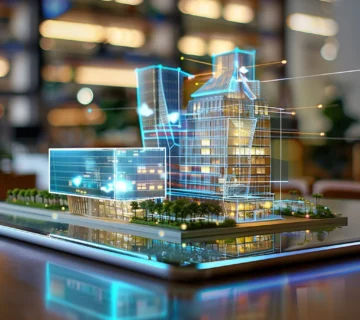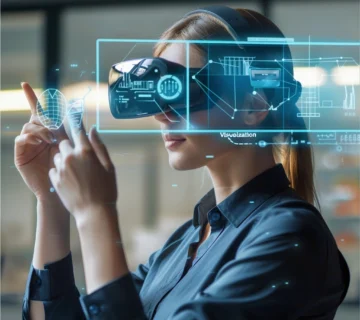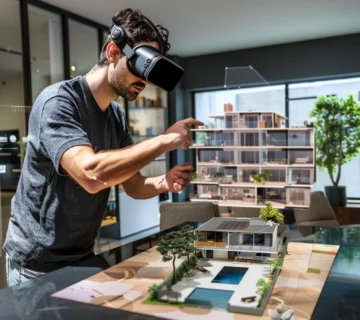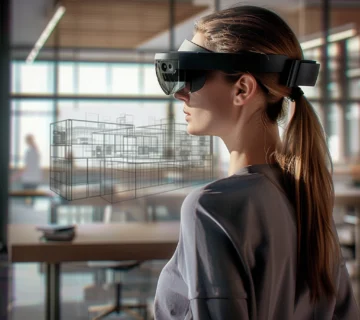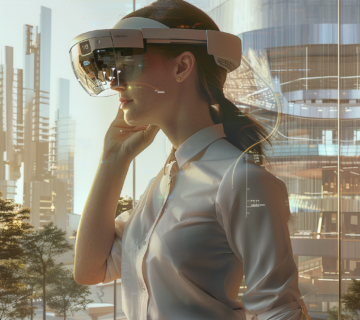Top 10 Best Augmented Reality Design Experiences in the Architectural Visualization Industry
Augmented Reality Design Experiences
Introduction:
The integration of AR technology solutions into the field of architecture has ushered in a new era of innovation and creativity, revolutionizing the way architects conceive, communicate, and experience architectural designs. Augmented reality, with its ability to seamlessly blend digital content with the physical world, offers architects and designers unprecedented opportunities to visualize and interact with their creations in real-time and at scale. From immersive experiences that allow stakeholders to explore proposed designs within their actual environments to hands-free access to critical information with AR-enabled devices, the possibilities for augmented reality in architecture are vast and transformative.
In this article, we delve into the diverse landscape of augmented reality technologies shaping the architectural industry. From powerful AR headsets like HoloLens 2 and Magic Leap One to versatile software development kits such as ARKit and ARCore, each tool and platform plays a pivotal role in advancing “Augmented Reality Design.” We explore how these technologies empower architects to transcend traditional boundaries, fostering collaboration, enhancing decision-making, and revolutionizing the design process.
Furthermore, we examine the impact of augmented reality on key aspects of architectural practice, including design visualization, collaboration, and client engagement. Through case studies and examples, we illustrate how architects leverage augmented reality to create immersive experiences that bring their designs to life, facilitate communication with stakeholders, and streamline project workflows.
As we navigate through the transformative landscape of augmented reality in architecture, it becomes clear that the convergence of digital and physical realms opens up a realm of possibilities, paving the way for a more dynamic, efficient, and engaging architectural practice. From concept development to project delivery, augmented reality is reshaping the future of architecture, empowering architects to realize their visions and redefine the built environment in unprecedented ways.
“Augmented Reality (AR) is the technology in the spectrum of mixed reality that enables layering of virtual objects onto real life, usually through the screen of a mobile phone or tablet. In the reality-virtuality continuum, AR lies in between the real environment and Augmented Virtuality (AV) or Virtual Reality (VR)”.[zoolatech]
as it mentioned in the augmented reality definition in the context of AR Development Services, the synergy between Augmented Reality and AR Visualization Tools aligns seamlessly with the foundational principles of augmented reality.
Architectural Visualization Industry
The architectural visualization industry has undergone a remarkable evolution, driven by the convergence of cutting-edge technologies such as augmented reality (AR) and virtual reality (VR). These advancements have revolutionized the traditional methods of presenting architectural designs, offering a myriad of interactive and immersive experiences to architects, designers, and clients alike. Through AR, stakeholders can overlay digital models onto the physical environment, allowing them to assess spatial relationships, material finishes, and lighting conditions with unprecedented realism.
VR, on the other hand, transports users into fully immersive virtual environments, enabling them to explore architectural spaces as if they were physically present, regardless of geographical location. These technologies have not only enhanced the design review and approval process but have also fostered greater collaboration among project teams by providing a common platform for visual communication and decision-making.
Moreover, the architectural visualization industry has seen a surge in demand for photorealistic 3D renderings and animations, as they offer compelling visualizations that aid in marketing, fundraising, and public engagement efforts. As AR and VR technologies continue to mature and become more accessible, the architectural visualization industry stands at the forefront of innovation, poised to redefine the future of architectural design and communication.

Augmented Reality development services:
Augmented Reality Design encompass a broad range of offerings aimed at creating and implementing augmented reality experiences for various applications and industries. These services typically involve the following:
Consultation and Strategy: AR development services often begin with consultation sessions to understand the client’s objectives, target audience, and technical requirements. Development teams work closely with clients to devise a strategic plan for implementing AR solutions effectively.
Custom AR App Development: One of the core services offered is the development of custom AR applications tailored to the client’s specific needs. This Augmented Reality Design involves designing and building applications that overlay digital content onto the real-world environment through smartphones, tablets, wearable devices, or specialized AR glasses.
Content Creation: AR development services may include content creation, such as 3D modeling, animation, and graphic design. This involves creating digital assets that are integrated into AR applications to provide immersive experiences for users.
Integration with Existing Systems: Many businesses require AR solutions that integrate seamlessly with their existing systems, such as websites, mobile apps, or enterprise software. AR development services can provide expertise in integrating AR functionality into existing platforms, ensuring compatibility and smooth operation.
Cross-Platform Development: To reach a wider audience, Augmented Reality Design and development services often include cross-platform development capabilities. This involves creating AR applications that are compatible with various devices and operating systems, such as iOS, Android, Windows, and more.
AR Cloud Services: Some AR development services offer AR cloud solutions, which enable the storage and sharing of spatial data to support persistent AR experiences. AR cloud services facilitate the synchronization of digital content across different devices and locations, enhancing the continuity of AR interactions.
Training and Support: AR development services typically provide training and support to help clients understand and effectively use their AR applications. This may include user training, technical support, troubleshooting, and ongoing maintenance to ensure the smooth operation of AR solutions.
Augmented Reality Design: AR development services often involve expertise in Augmented Reality Design principles to create intuitive and engaging user experiences. Design aspects such as user interface (UI) design, interaction design, and user experience (UX) design are crucial for developing AR applications that are easy to use and visually appealing.
Overall, AR development services aim to leverage the capabilities of augmented reality technology to enhance customer experiences, improve business processes, and drive innovation across various industries. By combining technical expertise with creative design solutions, AR development services help businesses unlock the full potential of augmented reality to achieve their goals and stay ahead in today’s digital landscape.
Morpholio AR SketchWalk:
Morpholio’s AR SketchWalk leverages the power of “Augmented Reality Design” to seamlessly merge digital architectural concepts with real-world environments as AR development services . Through this technology, architects and designers can experience their creations in a new dimension, as AR overlays their designs onto the physical spaces captured by the device’s camera. Augmented Reality Design facilitates an immersive and interactive visualization experience, enabling professionals to assess their projects in real-time and at scale, ultimately enhancing the design process and decision-making capabilities.
SketchUp Viewer AR:
SketchUp Viewer AR utilizes cutting-edge “Augmented Reality Design” to transform static 3D models into dynamic, interactive experiences within the physical environment. This innovative technology enables architects and designers to go beyond traditional presentations by seamlessly integrating their designs into the real world. With SketchUp Viewer AR, professionals can showcase their projects in context, allowing clients and stakeholders to fully immerse themselves in the envisioned space. By leveraging “Augmented Reality Design,” users can explore and interact with architectural designs as if they were physically present, enhancing communication and understanding. This immersive approach revolutionizes the presentation process, providing a more comprehensive and engaging experience for all involved parties.
Magic Leap One:
Magic Leap One introduces a new era of immersive spatial computing experiences through its advanced AR headset technology. By seamlessly integrating digital content with the real world, architects can leverage “Augmented Reality Design” to revolutionize the presentation and interaction of architectural models. With Magic Leap One, users can overlay intricate digital models onto their physical surroundings, offering a transformative way to visualize and interact with designs. This groundbreaking approach enables architects to explore spatial relationships, test design concepts, and communicate ideas in ways previously unimaginable. By embracing “Augmented Reality Design,” Magic Leap One empowers architects to push the boundaries of traditional design methodologies and create captivating experiences that redefine how architectural designs are presented and experienced.

HoloLens 2
HoloLens 2, crafted by Microsoft, epitomizes the pinnacle of AR headset technology, offering architects unparalleled immersive experiences in Exterior & interior visualizing in AR. Through its advanced capabilities, HoloLens 2 facilitates seamless integration of digital designs into the physical world, propelling “Augmented Reality Design” to new heights.
Architects harness this technology to collaborate in real-time, transcending geographical barriers and fostering dynamic teamwork. Furthermore, HoloLens 2 empowers architects to visualize their creations at scale, allowing them to perceive intricate details and spatial relationships with unprecedented clarity and accuracy. By interacting with holographic representations of their projects, architects delve deep into immersive experiences, exploring design iterations and refining concepts with unparalleled precision. With “Augmented Reality Design” at its core, HoloLens 2 heralds a paradigm shift in architectural visualization, revolutionizing the way architects conceive, communicate, and bring their visions to life.
ARKit and ARCore:
ARKit and ARCore, offered respectively by Apple and Google, stand as pivotal tools in the realm of “Augmented Reality Design,” providing software development kits that empower developers to craft immersive AR experiences for iOS and Android devices. These platforms serve as catalysts for architects and designers, offering a gateway to unlock the potential of AR in architectural visualization. By harnessing ARKit and ARCore, professionals can delve into the realm of spatial computing, creating applications that seamlessly overlay digital architectural models onto the physical world. This transformative approach revolutionizes the design process, allowing architects to envision their creations in context and interact with them in real-time.
Furthermore, ARKit and ARCore democratize access to “Augmented Reality Design,” enabling architects and designers to reach broader audiences through smartphones and tablets. By developing AR applications, professionals can engage clients and stakeholders in immersive experiences, offering them a glimpse into the future of architectural spaces. Whether it’s visualizing proposed designs within existing environments or exploring conceptual ideas in new contexts, ARKit and ARCore empower architects to push the boundaries of traditional design methodologies and redefine how architectural concepts are conceived, communicated, and experienced.

ArchiCAD’s BIMx with AR:
ArchiCAD’s BIMx with AR integration epitomizes the fusion of “Augmented Reality Design” with Building Information Modeling (BIM), offering an unparalleled tool for architects and stakeholders alike. By seamlessly blending digital architectural designs with real-world environments, BIMx with AR transcends traditional visualization methods. Users can explore architectural designs within the context of their surroundings, enabling a holistic understanding of the proposed structures.
This innovative approach revolutionizes the architectural design process, empowering architects to present their visions with unprecedented clarity and depth. Clients and stakeholders can immerse themselves in virtual walkthroughs, experiencing buildings before they’re constructed. Through this immersive experience, AR enhances communication and fosters a shared understanding of the project’s objectives and design intent.
Furthermore, by leveraging “Augmented Reality Design,” ArchiCAD’s BIMx app democratizes access to architectural visualization. Clients and stakeholders can interact with designs directly on their mobile devices, democratizing access to architectural visualization. This accessibility fosters greater engagement and collaboration throughout the project lifecycle, ultimately leading to more informed decision-making and enriched architectural outcomes.

Adobe Aero:
Adobe Aero represents a significant leap forward in democratizing “Augmented Reality Design,” offering architects and designers a powerful tool to create immersive AR experiences without the need for coding expertise. By seamlessly integrating with Adobe’s creative ecosystem, Aero enables professionals to breathe life into their 2D and 3D designs, transforming them into interactive AR presentations.
With Adobe Aero, architects and designers can transcend the limitations of traditional design review processes. By overlaying digital models onto real-world environments, stakeholders can visualize proposed designs in context, fostering a deeper understanding of spatial relationships and design intent. This immersive experience revolutionizes the design review and approval process, facilitating more informed decision-making and streamlined communication.
Moreover, Adobe Aero empowers architects and designers to engage with their designs in new and dynamic ways. Through interactive AR experiences, users can manipulate objects, explore spatial configurations, and test design iterations in real-time. By leveraging “Augmented Reality Design” capabilities, Adobe Aero redefines the boundaries of architectural visualization, unlocking limitless possibilities for creativity and collaboration in the digital age.
DAQRI Smart Glasses:
DAQRI Smart Glasses represent a pioneering advancement in the realm of “Augmented Reality Design,” particularly for industrial and architectural applications. These glasses seamlessly integrate AR capabilities, providing architects with hands-free access to digital information and overlays directly within their field of view. This transformative technology revolutionizes the way architects visualize and interact with designs, offering a dynamic and immersive experience.
With DAQRI Smart Glasses, architects can transcend traditional methods of architectural visualization. By overlaying digital models onto the physical environment in real-time, professionals gain unparalleled insight into spatial relationships and design concepts. This immersive approach to “Augmented Reality Design” empowers architects to explore design iterations, evaluate scale and proportion, and communicate ideas with precision and clarity.
Moreover, DAQRI Smart Glasses enhance productivity and efficiency by providing architects with on-demand access to critical information and tools. By integrating digital overlays seamlessly into their workflow, professionals can streamline design processes and make informed decisions in real-time. This integration of AR technology into architectural practice not only enhances the design experience but also fosters innovation and creativity in the field.
BIM 360’s Model Coordination with AR:
Autodesk’s BIM 360 platform, in conjunction with AR technology, heralds a transformative shift in the realm of “Augmented Reality Design,” particularly within the construction industry. Through seamless integration, BIM 360’s Model Coordination with AR empowers architects and construction teams to streamline model coordination and clash detection processes directly in the field. This innovative approach enhances efficiency and accuracy by allowing stakeholders to overlay BIM data onto the physical environment, facilitating on-site decision-making and problem-solving.
By leveraging AR technology, architects and construction teams can visualize complex BIM data in real-world contexts, enabling a deeper understanding of spatial relationships and potential clashes. This immersive experience revolutionizes traditional clash detection methods, empowering stakeholders to identify and address issues before they escalate, thereby minimizing costly rework and delays.
Furthermore, BIM 360’s Model Coordination with AR fosters greater collaboration and communication among project teams. By providing hands-on access to BIM data through AR overlays, stakeholders can engage in more informed discussions and make data-driven decisions on-site. This integration of “Augmented Reality Design” into the construction workflow not only enhances productivity but also elevates the quality of project outcomes, ultimately leading to more efficient and successful construction projects.
Wikitude SDK:
The Wikitude SDK represents a cornerstone in the realm of “Augmented Reality Design,” providing architects and designers with a versatile toolkit to craft immersive AR applications tailored to their specific needs. With its broad applicability across industries, including architecture, the Wikitude SDK empowers professionals to unlock the potential of AR technology in visualizing designs and engaging stakeholders.
Architects and designers harness the capabilities of the Wikitude SDK to develop custom AR experiences that transcend traditional visualization methods. By seamlessly integrating digital designs into the physical environment, professionals can offer stakeholders a compelling and interactive glimpse into proposed architectural projects. Through AR overlays, users can explore spatial relationships, assess design concepts, and visualize the impact of architectural interventions in real-time, enhancing the design review and approval process.
Moreover, the Wikitude SDK facilitates the creation of dynamic and immersive AR experiences that foster greater engagement and collaboration among project stakeholders. By enabling architects and designers to develop tailored AR applications, the SDK empowers them to communicate their design vision effectively and engage stakeholders in meaningful interactions with architectural concepts. This integration of “Augmented Reality Design” into the architectural workflow not only enhances the presentation of designs but also facilitates more informed decision-making, ultimately leading to better-designed and more successful architectural projects.
In conclusion, the convergence of augmented reality (AR) technology with architectural design has ushered in a new era of innovation, collaboration, and visualization. Each tool and platform discussed, from Morpholio AR SketchWalk to Wikitude SDK, represents a significant advancement in the field of “Augmented Reality Design,” offering architects and designers unprecedented opportunities to explore, communicate, and refine their creations.
Through seamless integration of digital models with real-world environments, these technologies empower professionals to transcend traditional boundaries, enabling immersive experiences that enhance understanding, decision-making, and collaboration. From hands-free access to digital information with DAQRI Smart Glasses to the creation of custom AR experiences with Adobe Aero, the possibilities for architectural visualization are boundless.
Moreover, the democratization of AR technology through platforms like ARKit and ARCore ensures that these transformative capabilities are accessible to a broader audience, democratizing access to architectural visualization and fostering greater engagement and collaboration.
As we continue to embrace and refine “Augmented Reality Design,” we can anticipate further advancements that will reshape the way we conceive, communicate, and experience architectural spaces. With creativity, innovation, and a commitment to harnessing the full potential of AR technology, architects and designers are poised to unlock new dimensions of possibility and redefine the future of architectural design.



